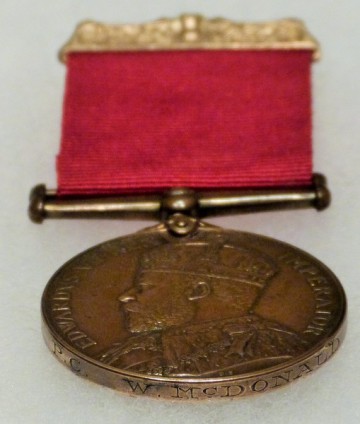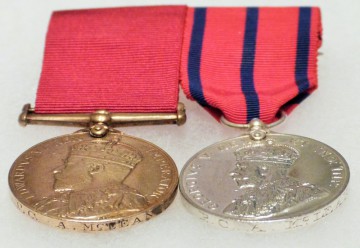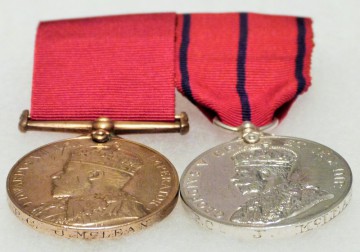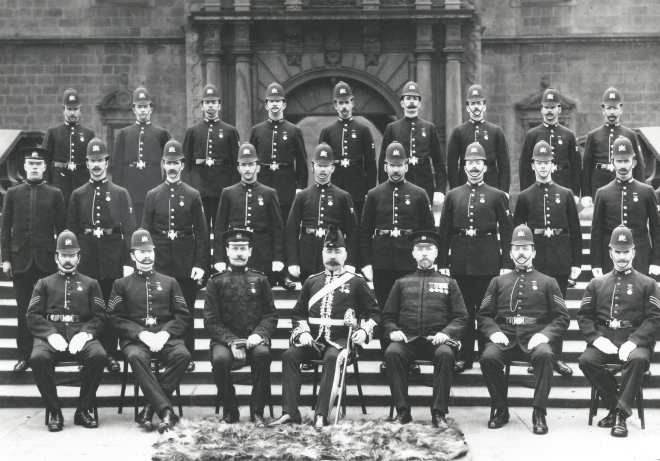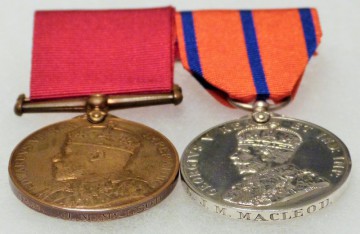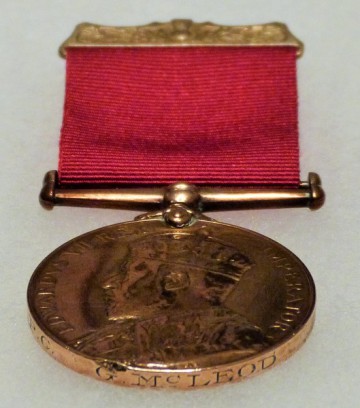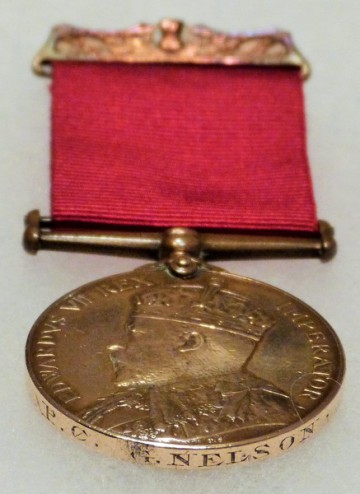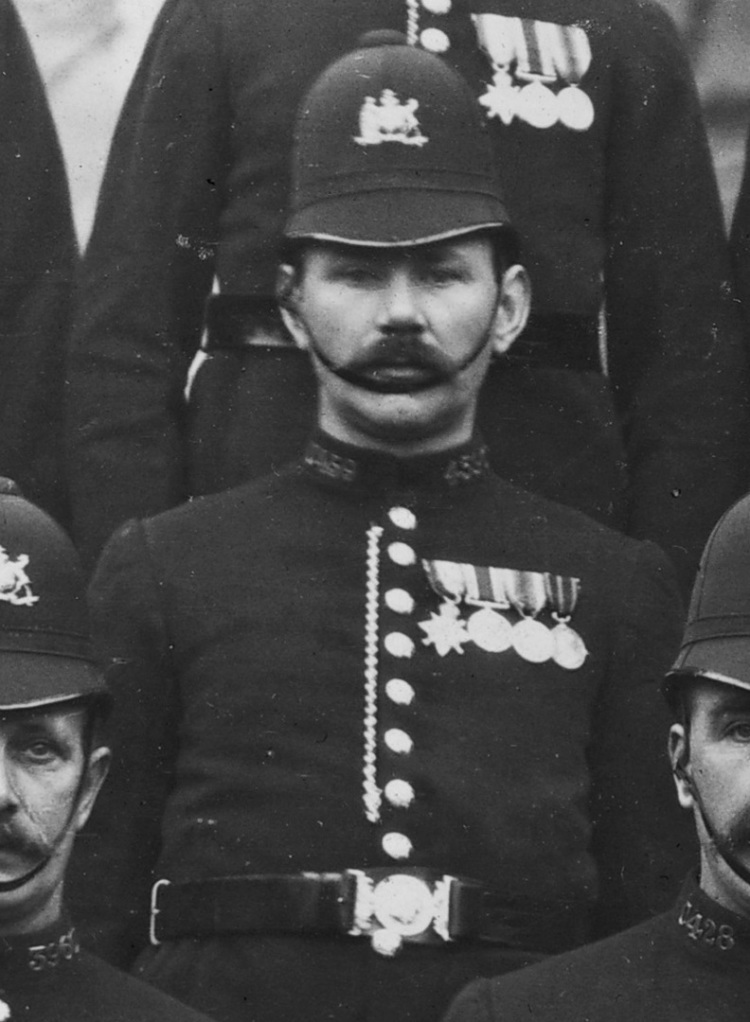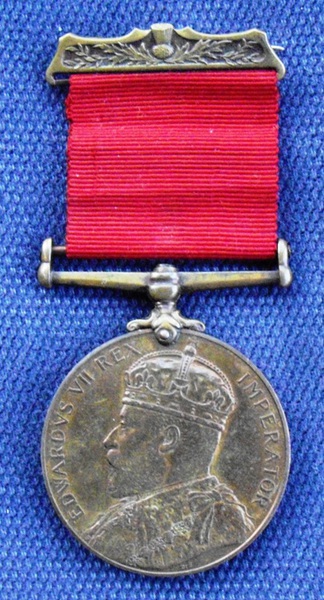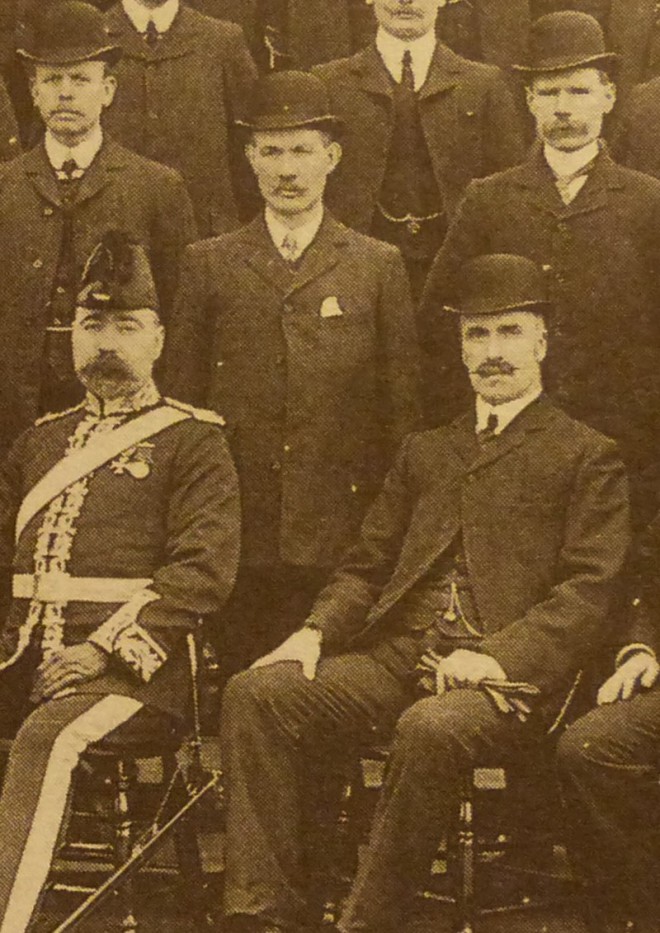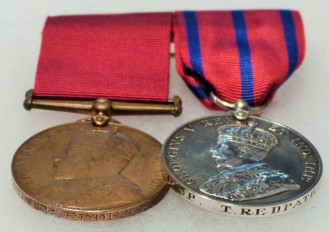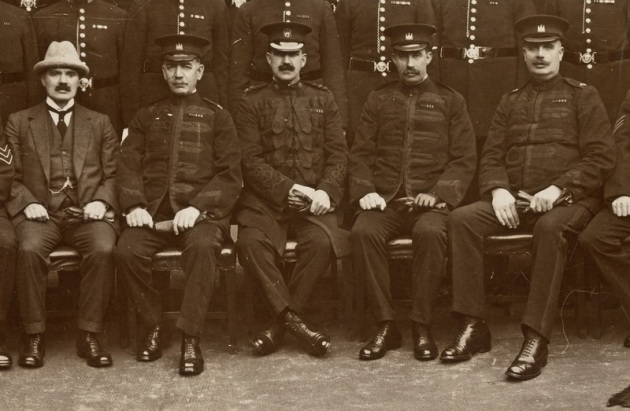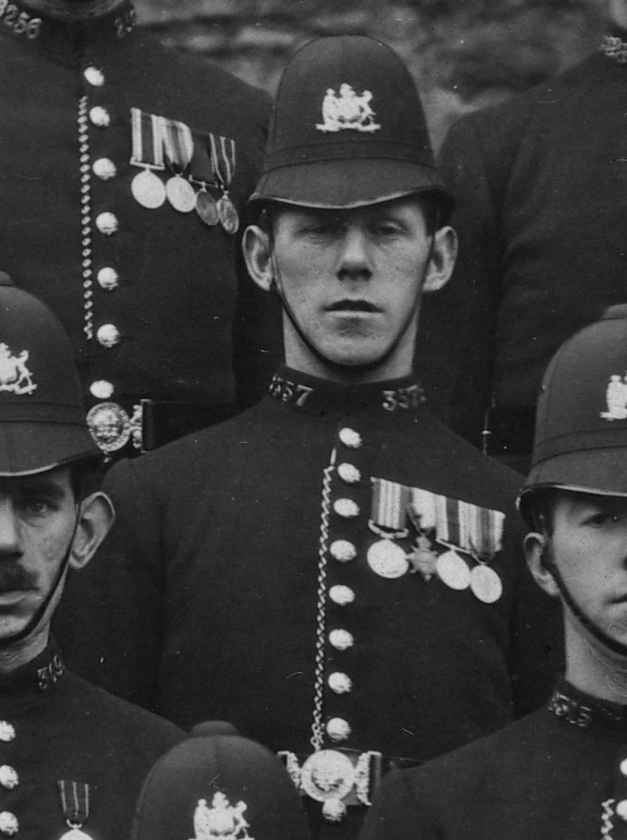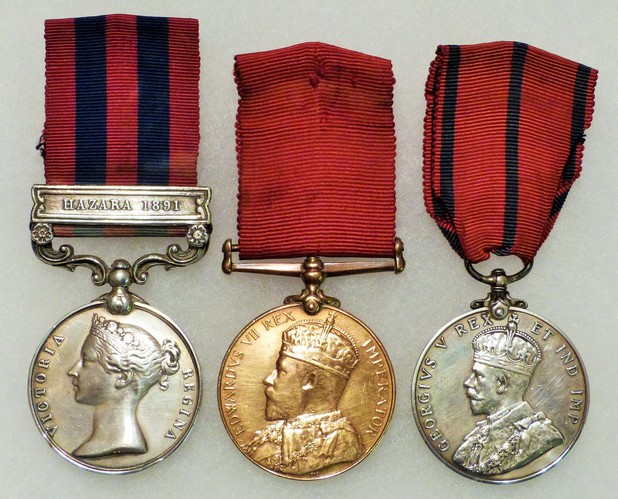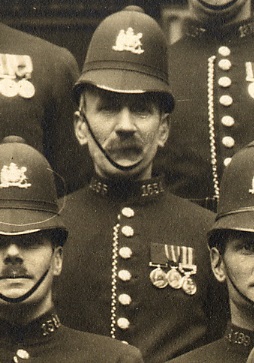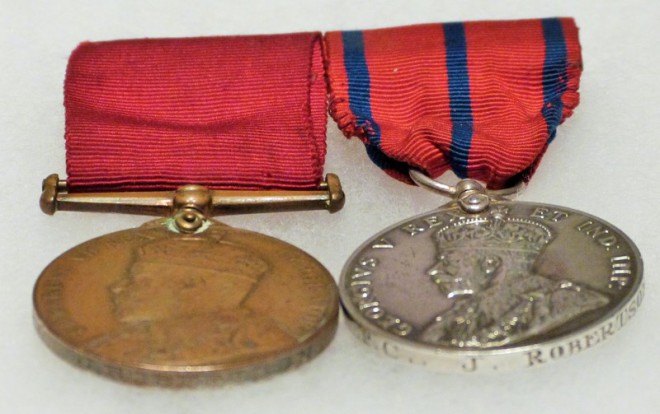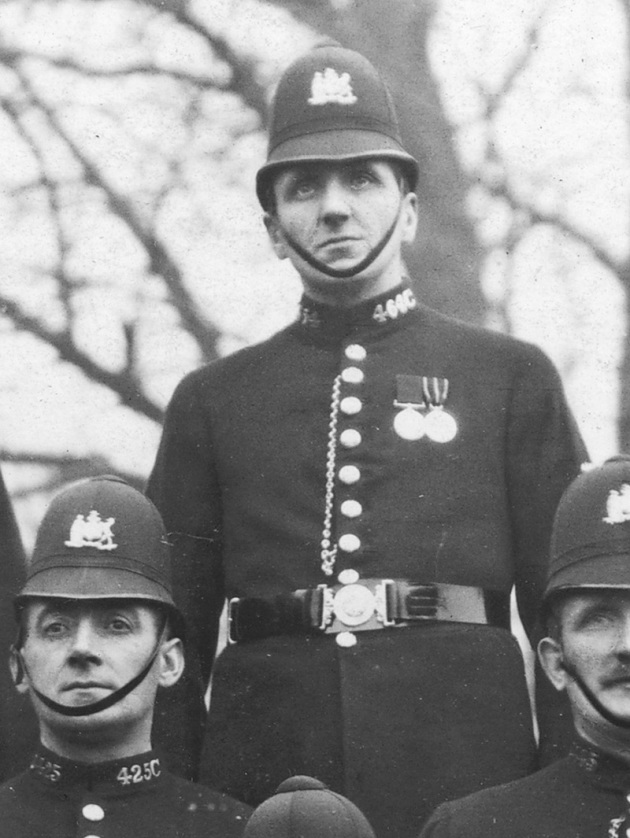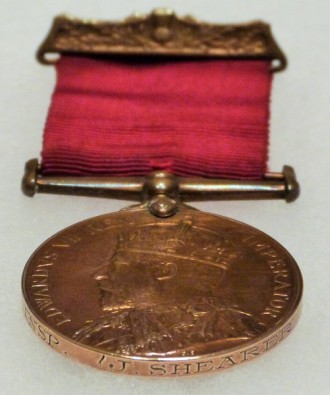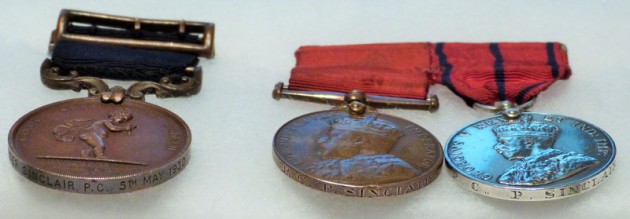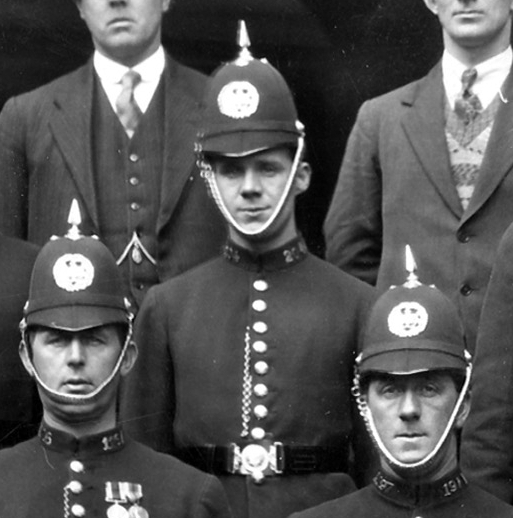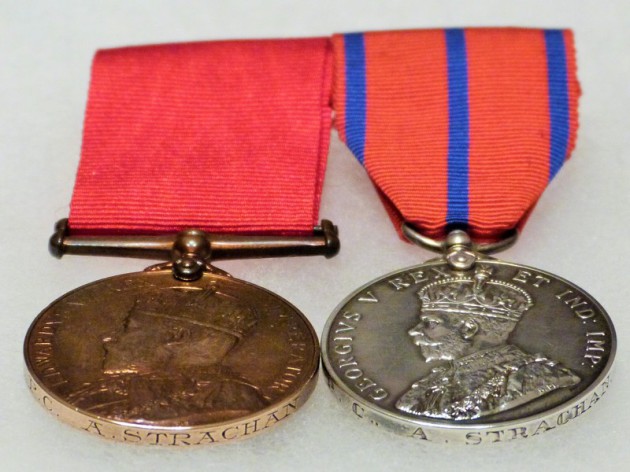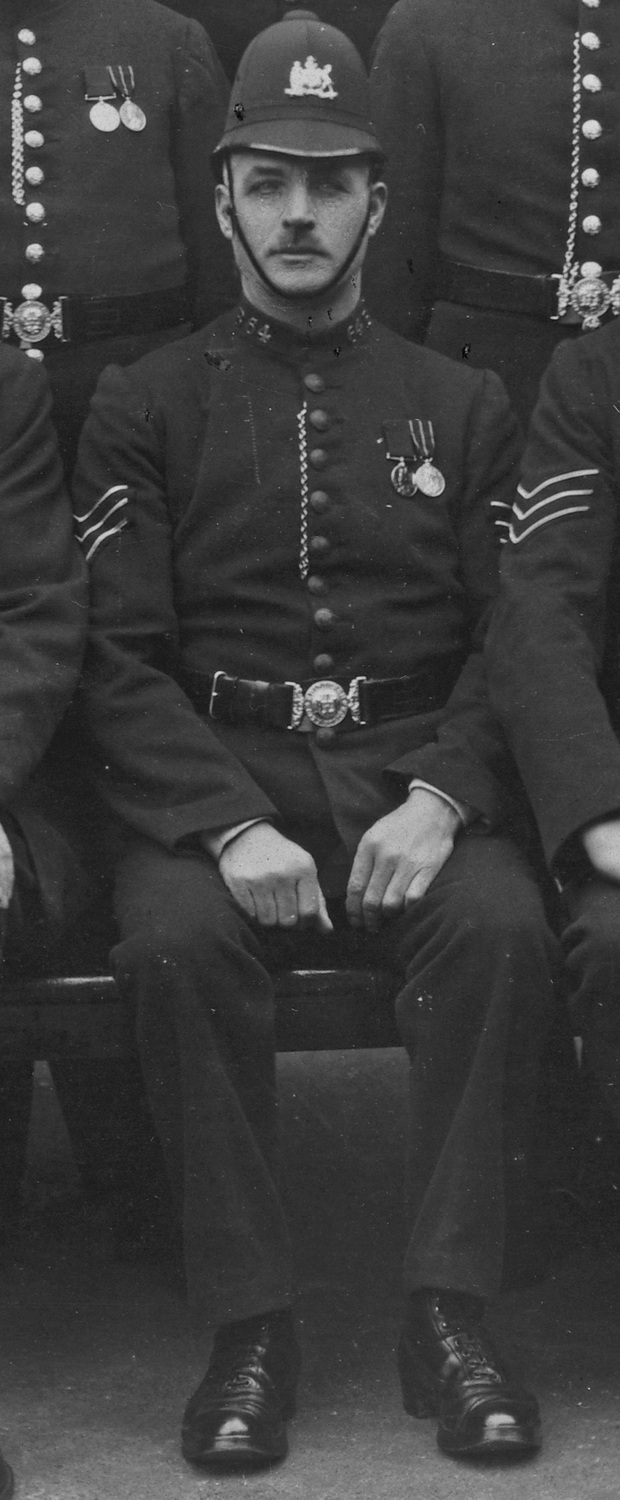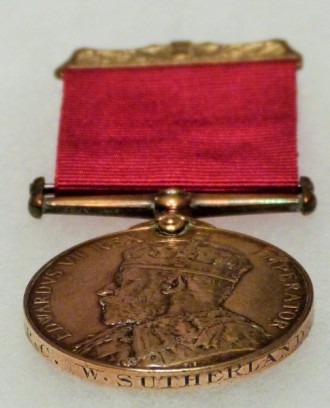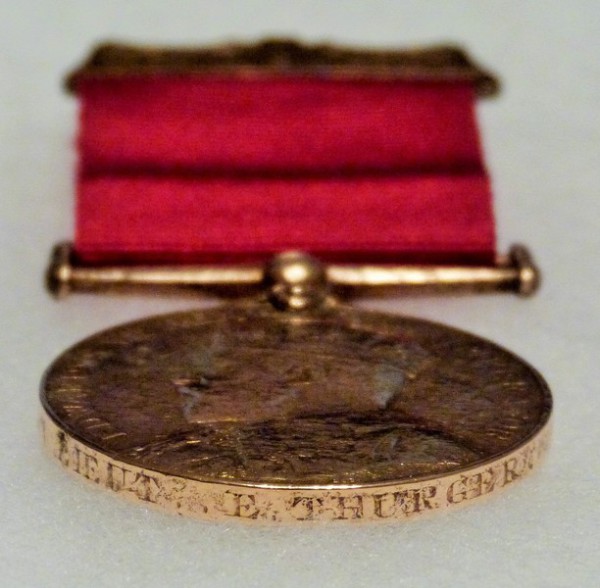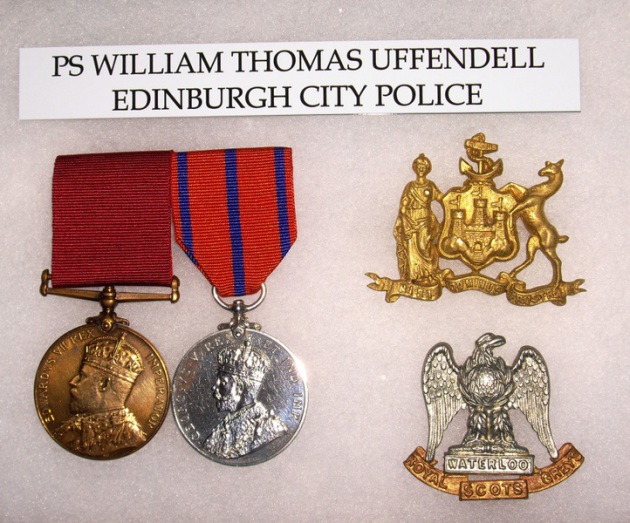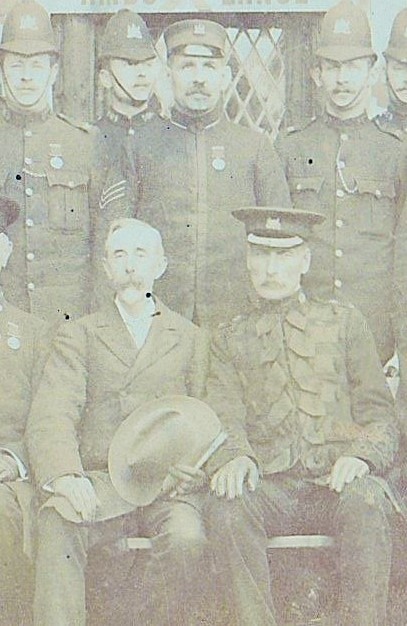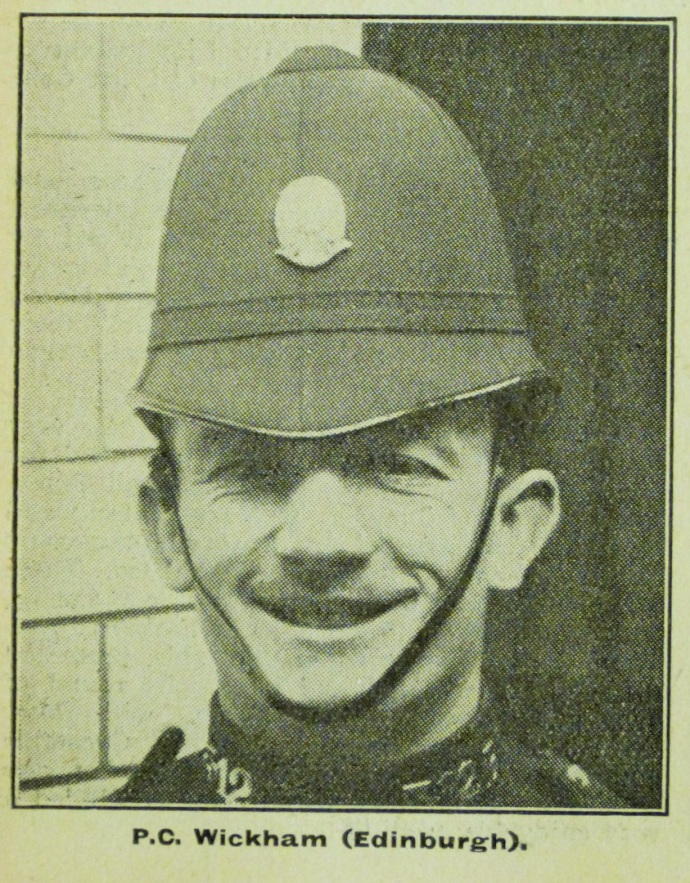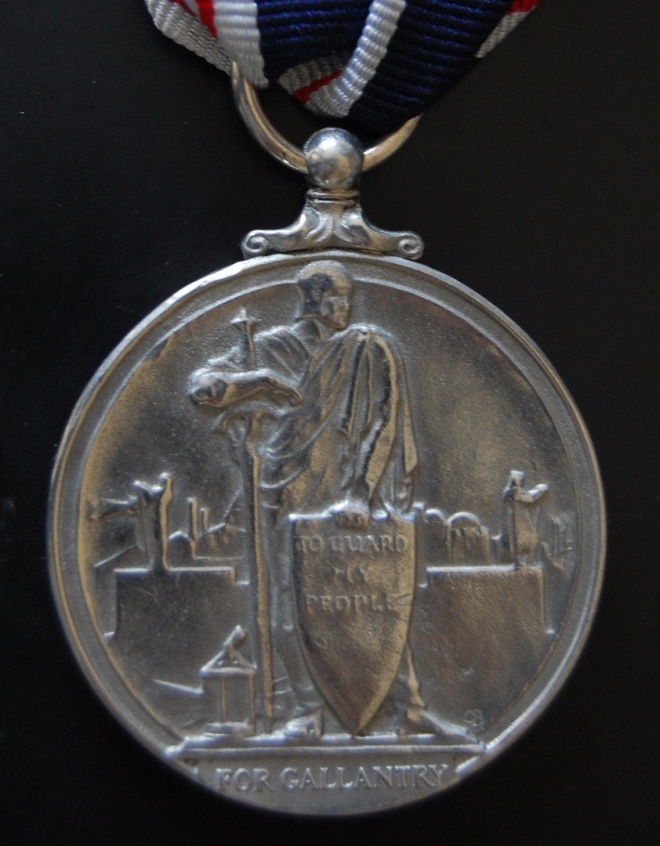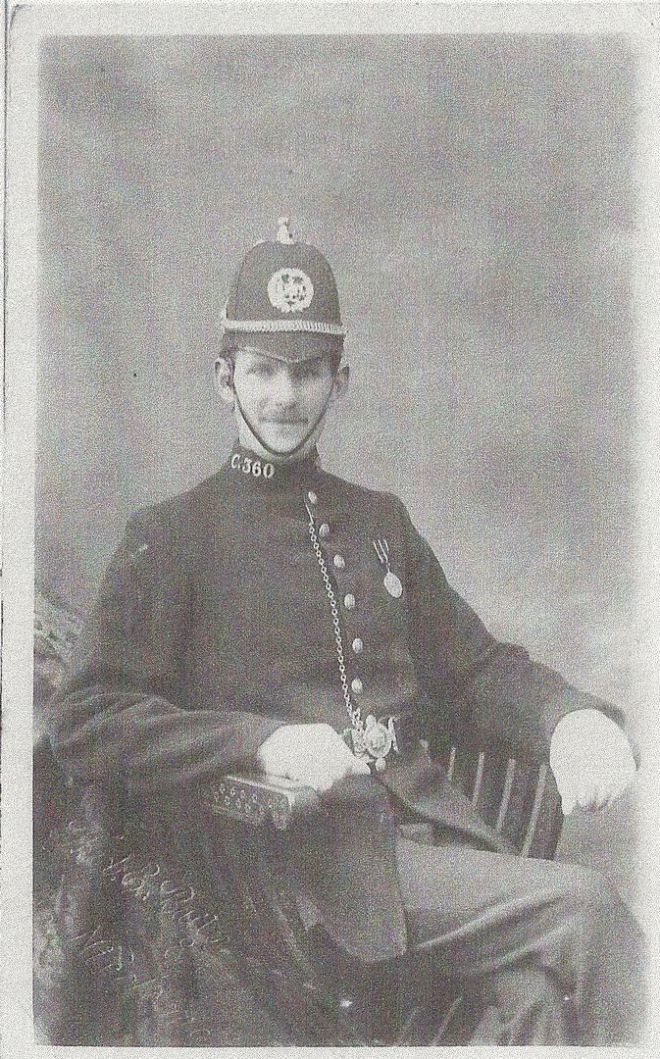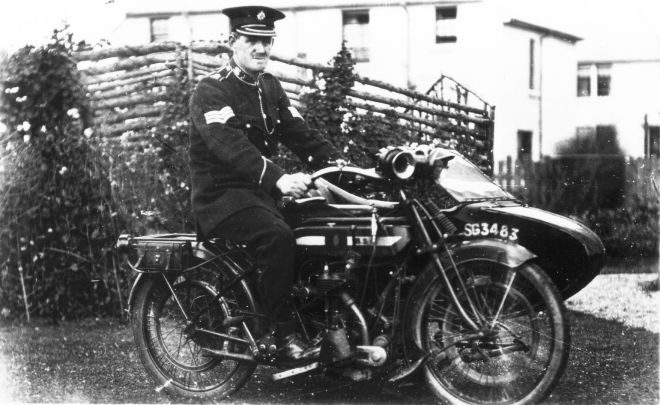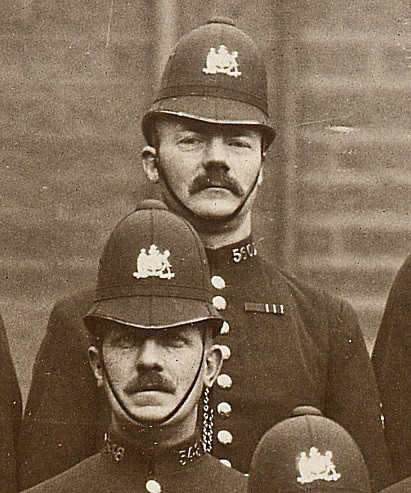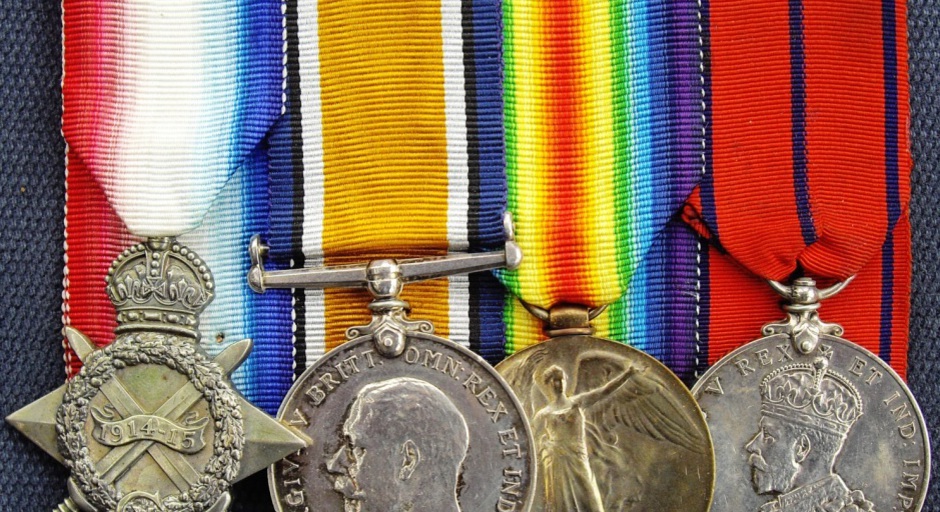
Edinburgh City Police 1805 - 1975
McDonald to Uffendell
PC William McDonald Edinburgh City Police
PC Alexander McLean Edinburgh City Police
PC John McLean Edinburgh City Police
PC 211 B James McLellan Edinburgh City Police
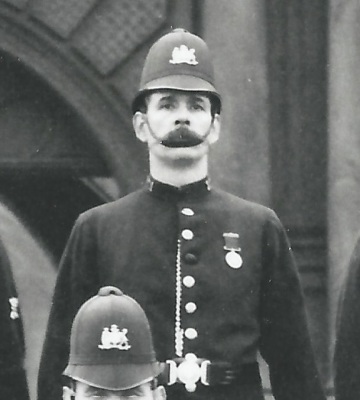 PC 211 James McLellan Edinburgh City Police at Funeral of King Edward VII 20 May, 1910 wearing his 1903 Medal
PC 211 James McLellan Edinburgh City Police at Funeral of King Edward VII 20 May, 1910 wearing his 1903 Medal
King Edward VII Police (Scotland) Medal 1903
King George V Coronation (Scottish Police) Medal 1911
Edinburgh City Police
PC 211 B James McLellan
James Frame McLellan was born at Turfholm, Lesmahgow in the County of Lanark on 17 September, 1864.
By 1871, he was living with his Step-father and Mother at the Old Schoolmaster’s House in Uphall, West Lothian.
When his sister Margaret Cowan McLellan was born in 1877, the family were living at 63 Hopetoun Street, Bathgate in West Lothian.
James McLellan, a Blacksmith, joined Edinburgh City Police on 27 July, 1887. His original Collar Number was 272 B.
By 1891, the family, James and Elizabeth, both now 46 and their children, James, (25) and a Police Constable and Margaret, (15), a Scholar, were living at 20 Barony Street, Edinburgh.
By 1898, when Margaret died of tuberculosis, the family, including PC James McLellan, were now living at 58 Broughton Street, Edinburgh.
They were still at that address in the Census of 1901.
Later that year on 25 June, 1901, under a Warrant issued by the Sheriff Substitute of the Lothians and Peebles, James McLellan, (36), Police Constable of 58 Broughton Street, Edinburgh, married Catherine Craik, (25), a Spinster of 15 Upper Gilmore Place, Edinburgh.
Like all of the Edinburgh City Police, PC James McLellan was awarded the King Edward VII Police (Scotland) Medal, 1903 for being on duty for the Royal Visit to Scotland that year.
Between 1902 and 1909, the couple had five children, all born in 7 Heriothill Terrace, Bellevue in Edinburgh. They were, Elizabeth Frame McLellan in 1902, Margaret Matilda McLellan in 1904, James McLellan in 1906, Alexander Robertson McLellan in 1908 and Helen Catherine McLellan in 1909. Helen Catherine died aged 1 in 1911 at home.
PC James McLennan was one of only 18 constables from Edinburgh City Police selected to provide a Guard of Honour representing the Scottish Police in London at the Funeral of King Edward VII on 20 May, 1910. He can be seen wearing the 1903 King’s Medal in the picture below.
Catherine's death is confirmed by the Census of 1911which shows the couple having been married for 9 years, had 5 live births, 4 of whom were still alive at the date of the Census.
All 598 Edinburgh City Police officers were awarded the King George V Coronation (Scottish Police) Medal, 1911 and these were presented to the men by the Lord Provost in two separate ceremonies at the City Chambers in 1912.
On 6 June, 1913, PC Mclellan "was appointed to act as Sergeant when necessary".
Elizabeth Frame or McLellan, (76), died in the Poorhouse in Craiglockhart on 26 October, 1918. Her usual address was 7 Heriothill, Edinburgh.
James Frame McLellan retired on pension from Edinburgh City Police on 26 September, 1921 when he was 57.
On 1 November, 1930, at 9 Rossland Place, Kinghorn in the County of Fife, James Frame McLellan, (66), a Retired Police Constable, died. His daughter, Elizabeth, registered his death.
Under the provisions of the Police (Scotland) Pensions Acts, Catherine recieved a Widow's Pension based on James' contributions. The regulations in force then state that "The pension to a widow shall continue only while she remains a widow and is of good character."
Catherine McLellan, widow of James Frame McLellan, Police Constable, died on 30 December, 1946 at Edinburgh Royal Infirmary aged 70. Her usual address was 46 Claremont Bank in Edinburgh. Her son, James McLellan, registered her death.
The Funeral of King Edward VII 1910
The Scotsman newspaper of Wednesday 18 May, 1910 reported:
|
“EDINBURGH POLICE FOR THE FUNERAL”
“Chief Constable Ross has received notice from His Majesty the King, through the Secretary for Scotland to attend the funeral of King Edward in London on Friday with twenty five officers and men of the Edinburgh City Police.
The detachment will leave for London tomorrow morning.
It will be recalled that similar distinction was conferred upon the Edinburgh City Police on the occasion of the funeral of Queen Victoria.”
|
The Friday 20 May, 1910 edition of The Scotsman reported:
|
“THE EDINBURGH POLICE FOR THE FUNERAL”
“A detachment of twenty four members of the Edinburgh City Police force, under the command of Chief Constable Ross, left the Waverley Station yesterday for the purpose of taking a place in the funeral procession in London today.
The company, in addition to the Chief Constable, consists of one Lieutenant, one Inspector, four Sergeants and eighteen Constables who were picked men on account of physique, irrespective of length of service, and includes Lieutenant Paterson, Inspector Bell, Sergeants Sim, Anderson, Stuart and Laing; Drill Instructor (P.C.) Dow, and Constables (No. 75) Murray, (136) Harcus, (204) MacFarlane, (211) McLellan, (222) Knipe, (273) Annand, (284) Valentine, (383) Lyall, (393) Donaldson, (398) MacDonald, (401) Wilson, (508) Muirhead, (53) Beattie, (545) Gillespie, (574) Lockie, (577) Speed and (594) Henderson.”
|
PS John McDonald McLeod Edinburgh City Police
King Edward VII Police (Scotland) Medal 1903
King George V Coronation (Scottish Police) Medal 1911
Edinburgh City Police
PS John McDonald McLeod
John McDonald McLeod, the elder brother of PC George McLeod below, was born in Bardintuah in the Parish of Latheron in the County of Caithness on 11 April 1869. His father was Kenneth McLeod, a Crofter and Grocer and his mother, Janet Sutherland or McLeod. His parents were married on 28 October 1853 at Latheron.
Janet died in 1889 in the Post Office at Latheron. By 1891, John McLeod was a Police Constable in Edinburgh City Police.
By 1901, John and his father were living at 44 Argyle Place, Portobello in Edinburgh with the family of their sister/daughter Lucy.
In 1909, John McDonald McLeod married Laura Biddle.
Later that year, Laura Lucy McLeod was born at 36 Millar Crescent, Morningside in Edinburgh.
The family were still at that address in 1911.
The weekly Record dated 23 December 1919 records under ‘Retired on Pension’ that “PS 44 John M. McLeod (Certified Physically Unfit) (retired) on 22 inst.”
John McDonald McLeod died aged 80 in 7 St John’s Road, Glasgow on 26 July 1949. His son-in-law, William Steven registered the death.
Note: the spelling of McLeod and MacLeod is used in both forms in several Police and Birth, Death and Marriage documents concerning John and George Mc/MacLeod.
PC George McLeod Edinburgh City Police
PC George William Nelson Edinburgh City Police
King Edward VII Police (Scotland) Medal 1903
Edinburgh City Police
PC George William Nelson
George William Nelson joined Edinburgh City Police as a temporary Constable for Cabling Operations in 'B' Division on 14 February, 1899. His collar number was 733 B.
On 28 March, 1899, he was appointed to the Permanent ranks as PC 208 B.
He was 'Dismissed' from Edinburgh City Police on 29 March, 1906.
PC 459 C Thomas Patterson Edinburgh City Police
Edinburgh City Police
1914-15 Star
British War Medal
Victory Medal
King George V Coronation (Scottish Police) Medal, 1911
PC 459 C Thomas Patterson
Thomas Patterson was born on 26 June, 1886 at Bogangreen, Coldingham in Berwickshire. His father, John Patterson, registered his birth. His mother was Isabella Cottar or Patterson.
In the Census of 1891, he was living with his Grandmother, Agnes Walker or Patterson, his father and other relatives were registered at Whitecross in Coldingham, Berwickshire.
By 1901, the family were at Farm Cottage near Foulden in Berwickshire.
On 22 September, 1902, at Dunbar in East Lothian, Thomas Patterson, a Farm servant of Coldingham in the County of Berwick gave his age as ’18 years and 3 months’ (actual age 16 years) and enlisted on a Short Service Engagement (3 Years with the Colours, 9 Years with the Reserve) as Private 7701 in the Seaforth Highlanders.
He was described as 5’ 9.5”, fresh complexion, dark grey eyes and dark hair.
He was posted to Fort George near Inverness, the Depot of the Seaforth Highlanders.
His ‘next of kin’ is listed as ‘John Patterson, Foulden, New Mains near Berwick on Tweed’.
On 26 November, 1902, Henry Patterson, (his uncle), of 33 Balcarres Street, Morningside in Edinburgh wrote to the Commanding Officer of the Seaforth Highlanders Depot at Fort George who in turn wrote to Roderick Ross, the Chief Constable of Edinburgh City Police.
In response to the letter from the Commanding Officer at Fort George, on 30 November, 1902, Inspector Thomas Redpath of “D” Division of Edinburgh City Police made enquiries and then wrote to confirm that the content of Uncle Henry’s letter was genuine.
This report was forwarded to Fort George on 1 December 1902.
On 9 December, 1902, Private 7701 Thomas Patterson was convicted at Court Martial at Fort George of “Having made a mis-statement as to his age on enlistment contrary to Para.1805 (vi) (i) Kings Regulations” and discharged.
His conduct was described as “Good during his 79 days service”.
He joined Edinburgh City Police on 28 April 1908 when he was 21 years old. He was posted to D Division (the West End) as PC 583. One of his Inspector's Was Thomas Redpath.
On 19 November, 1908 he was transferred to C Division (the South Side) as PC 352.
He was living at 4 Rankeillor Street, Edinburgh when he married Georgina Virtue Cockburn, (24), of Lamberton, Berwickshire in Mordington, Berwickshire in 1910.
In 1912 -1913, He was living at 24 St Leonard's Street, Edinburgh. In 19-14 - 1915, he was on the Voter's Roll at 14 Moncrieff Terrace, Newington, Edinburgh.
He progressed through the pay scales and each is recorded in his Personnel Record. The only negative remark recorded was on 5 September, 1911 when he had “One days’ leave stopped for being 50 minutes late parading for duty”.
On 31 May, 1915, like many officers from Edinburgh City Police, he resigned to join the Army. His pay when he resigned was 34/5d per week (£1.70 very approximately).
He was posted as a Private, Number S/8782 in the 7th (Service) Battalion of the Seaforth Highlanders. He went to France in 1915.
The 7th Battalion was formed in 1914 at Fort George near Inverness as part of Kitchener’s First New Army before moving to Aldershot in Hampshire to join the 26th Brigade of the 9th Division. The Division later moved to Bordon in Hampshire before being deployed to Boulogne in France in May 1915 and thereafter taking part in actions on the Western Front.
During 1915, the 7th Seaforths were involved in the Battle of Loos. In 1916, they were involved in the Battle of Albert, the Battle of Bazentin, the Battle of Delville Wood and the Battle of Le Transoy. During 1917, the Battalion was involved in the First and Second Battles of the Scarpe, the First Battle of Passchendaele and the action of Welsh Ridge.
It was probably during one of these battles that Thomas Patterson, by now a Lance Corporal, received the leg injury that led to his discharge on 18 April, 1917. he suffered quite a serious gun shot wound (GSW) and his long recovery meant he was unable to resume his police career immediately.
He was, however, re-appointed to Edinburgh City Police on 30 March 1920 and posted to C Division as PC ‘359’. The entry in the Weekly Record was later corrected to ‘PC 459 C’. He was now on 86/- per week (£4.30 per week approximately).
The pay rise was awarded in 1919 to make up for the years of low pay and in response to the Police Strike of that year. Since then, it is unlawful for British police officers either to be members of a Trades Union or to withdraw their labour in strike action.
It is clear that Thomas Patterson still suffered badly from his leg injury which is described in police records as a ‘gunshot wound’ (GSW).
Between 1924 and 1925, Thomas Patterson spent a great deal of time in Craigleith Hospital in Edinburgh during which time one of his legs was amputated due to “septic poisoning of a gunshot wound to his leg”.
On the 1 October 1925, his Personnel Record states that “Service lost on account of disability to be reckoned as approved service for the purpose of Pension 18 April, 1917 to 29 March, 1920.Memo 658/25 approved by Town Council.”. This reflects a more considerate attitude to those injured in the service of their country of that time.
On 14 January, 1926, Thomas Patterson was “Advanced to 1st Good Conduct Class at 92/6d (£4. 80.5 approximately) per week”.
On 9 August 1927, PC 210 A Thomas Patterson was “Retired on Pension. Certified medically unfit. Certificate of character No.85 granted.”
After retirement he moved back to Berwickshire.
On 18 June 1930, Thomas Patterson, a ‘Retired Constable’ (Widower) married Janet Rae Nelson at New Mains, Foulden in Berwickshire.
Thomas Patterson died aged 83 in 1970 in Coldingham in Berwickshire.
In 1982, Janet Rae Nelson or Patterson died aged 85 in Eyemouth in Berwickshire.
Detective Officer Alexander Peebles Edinburgh City Police
Inspector Thomas Redpath Edinburgh City Police
King Edward VII Police (Scotland) Medal 1903
King George V Coronation (Scottish Police) Medal 1911
Inspector Thomas Redpath
Edinburgh City Police
Inspector Redpath joined Edinburgh City Police on 30 May 1882. He retired on pension on 1 March 1919.
(Please also see the entry of PC Thomas Patterson above.)
PC 357 B John McGhee Rennie MM Edinburgh City Police
PC 165 A George Renton Edinburgh City Police
India General Service Medal (Clasp for Hazara 1891)
King Edward VII Police (Scotland) Medal 1903
King George V Coronation (Scottish Police) Medal 1911
Edinburgh City Police
PC 165 “A” George Renton
George Renton was born on 1 July, 1870 (according to his date of birth on his Edinburgh City Police personnel record) although it may have been in 1869, at Tuperee, near Kirknewton in the County of Northumberland in England. His father was Robert Renton, a Land Steward and his mother, Elizabeth Kerr or Renton. His parents were married at Todrig farm near Greenlaw, Berwickshire on 8 August, 1856.
In the English Census of 1871, the family were living at Kirknewton in Northumberland where George, (1), was the youngest child of four sons and one daughter.
By the Scottish Census of 1881, the family were living at Fans Farm near Earlston in Berwickshire and George now had a younger sister.
On 4 April, 1887 at Edinburgh, George Renton, a Tailor aged 18 years and 7 months, joined the 1st Battalion Seaforth Highlanders as Private No. 2435. He had previously served in the 1st Berwickshire Rifle Volunteers.
Between 4 April, 1887 and 18 September, 1890, George Renton served in Edinburgh, Glasgow, Fort George and Dublin before leaving for the ‘East Indies’ where he served with the 2nd Battalion Seaforth Highlanders until 24 January, 1895.
His Army record confirms that he took part in the Hazara Campaign, 1891 for which he was awarded the India General Service Medal with the Clasp ‘Hazara 1891’. The Medal roll of the 2nd Btn Seaforths confirms his receipt of the medal and clasp.
On 25 January, 1895, by then a Lance-corporal, he was transferred to the Army Reserve.
On 29 March, 1895, George Renton joined Edinburgh City Police as PC 52 “A”. He then progressed through the pay grades and classes with no more discipline issues than the average constable of the time.
At 3 St John Street, Canongate in Edinburgh on 3 December 1895, George Renton, (27), Police Constable, married Agnes Clark, (23), a Domestic Servant. Agnes had been born in Greenlaw, Berwickshire.
In the Census of 1901, George and Agnes were living at 14 Dalgety Avenue in Edinburgh
In 1903, in common with every other officer in Edinburgh, he was awarded the King Edward VII Police (Scotland) Medal in commemoration of the Royal Visit to Scotland that year. The medal was presented to members of the force the following year at two ceremonies in Royal Exchange Square, Edinburgh.
At High Street, Greenlaw in Berwickshire on 4 September, 1904, Agnes Renton, (31), wife of George Renton (Police Constable) died. Her husband George Renton, registered her death.
On 27 March, 1908, at 31 Carnegie Street in Edinburgh, George Renton, (380, Police Constable and Widower, married Mary Tait, (42) a Spinster. Mary Tait had been born in Greenlaw in Berwickshire.
Robert George Renton was born on 7 April, 1910 at 31 Carnegie Street in Edinburgh. His father was Police Constable George Renton and his mother, Mary Tait or Renton.
In the Census of 1911, George, Mary and Robert George were still living at 31 Carnegie Street. In the same year, George Renton was also awarded the King George V Coronation (Scottish Police) Medal.
George Renton retired on Pension as PC 165 “A” on 2 July, 1923. His picture wearing his three medals can be seen above.
Mary Tait or Renton died at High Street in Greenlaw on 30 November, 1939. Her husband, George registered her death.
On 17 January, 1941, George Renton, (71), a Retired Police Constable, died at High Street, Greenlaw. His son, Robert George Renton registered the death.
PC 464 C James Robertson Edinburgh City Police
King Edward VII Police (Scotland) Medal 1903
King George V Coronation (Scottish Police) Medal 1911
Edinburgh City Police
PC 464 C James Robertson
James Robertson was born at Gallowhill, a few miles South East of Cargill in the County of Perth on 31 January 1880. His father was John Robertson, an Estate Labourer and his mother, Margaret Ralph or Robertson.
In the Census of 1981, the family were still living there. John, Margaret and their daughters Marjory, (18), Elizabeth, (7), Jane, (4) and their sons, Charles, (12), Robert, (9) and James, (1).
By the Census of 1891, Marjory, Charles and Robert had left home. ‘Lizzie’, (17), was there with her mother and father and Jane, (14), James, (11) and a cousin, William Meiklejohn, (4).
By 1901, James Robertson was living with his older brother John, (31) and his wife Agnes and their family at 25 Stewart Terrace (off Gorgie Road), Edinburgh. John was a’ Road Surfaceman’.
On 24 April, 1901, James Robertson joined Edinburgh City Police as PC 464 C working in the Southside of the City, probably working out of St Leonards Police Station.
His description was “5’ 10” tall, Dark Hair, Grey Eyes and a Fair Complexion.”
On 8 December, 1905 at 70 Balcarres Street, Morningside, Edinburgh, James Robertson married Janet Shearer, a Domestic Servant.
By 1911, they had three sons together, all of whom were born at 70 Balcarres Street, Edinburgh. John Alexander, born 17 September, 1906, James Ralph, born 29 May, 1908 and George Shearer born 12 September, 1910.
At some point in his career, he was transferred to Morningside Police Station as there exists correspondence from Inspector Campbell to Superintendent Hugh Calder dated 1922 referring to his being stationed there.
PC James Robertson retired on pension on 11 May, 1931.
On 22 August, 1961, James Robertson, (81) died in the City Hospital, Edinburgh. His usual address was 2 Pentland Terrace (off Greenbank Terrace), Edinburgh. His son, “James R. Robertson of 2 Pentland Terrace, Edinburgh” registered his death.
Janet Shearer or Robertson, (89), died in Morningside in 1971.
Inspector James Shearer Edinburgh City Police
King Edward VII Police (Scotland) Medal 1903
Edinburgh City Police
Inspector James Shearer
James Shearer joined Edinburgh City Police on 13 November 1883.
Some time prior to 1888, he was promoted to Sergeant (Collar Number 541).
By January, 1898 he had transferred to the Court Department at Headquarters and is recorded signing for copies of the Weekly Record.
Around 1902, he was promoted to Inspector, still in the Court Department.
He retired on Pension (on Medical Grounds) on 20 November, 1912.
He is probably also entitled to the King George V Coronation (Scottish Police) Medal, 1911.
PC Peter Sinclair Edinburgh City Police
King Edward VII Police (Scotland) Medal 1903
King George V Coronation (Scottish Police) Medal 1911
Royal Humane Society Bronze Medal 1930
Leith Burgh Police
PC Peter Shearer Sinclair
Peter Shearer Sinclair was born 27 January 1883 at Hundy on Stronsay in the County of Orkney.
Peter Sinclair joined Leith Burgh Police on 27 March 1902 and was awarded both the 1903 and 1911 medals while serving in that force.
On 2 November, 1920, Leith Burgh Police amalgamated in to Edinburgh City Police becoming first 'E' Division and later, 'D' Division.
However, right up until 1975 when Edinburgh City Police became part of Lothian and Borders Police, 'D' division was simply called 'Leith'.
Peter Sinclair was PC 622 "D".
He was awarded the Bronze Medal of the Royal Humane Society for attempting to save the life of a young man who had jumped in to Leith Docks on 30 May 1930.
The young man was James Campbell, (17), a Butcher’s assistant of 2 Portland terrace, Leith. His body was recovered from Leith Harbour at Commercial Street about 30 minutes past midnight on 6 May 1930
On 20 May 1930, the Edinburgh City Police weekly Record has the following entry under ‘Meritorious Conduct’:
|
Police Officer |
Comments |
|
PC 622 Peter Sinclair |
Highly commended for courageous conduct in attempting to rescue a man from drowning in Leith Harbour.
|
The minutes of the Royal Humane Society Committee Meeting of 17 June 1930 and chaired by Admiral C. J. Eyres, D.S.O record the following:
|
Number |
Name… Occupation… Person who saved or attempted to save Life |
Age |
Subject – Name Address and Occupation |
Age |
|
|
50226 |
Peter Sinclair Police Constable
|
47 |
James Campbell |
17 |
|
|
Time & Place |
Particulars |
Exertions of the Claimant |
|||
|
11 p.m. 5th May, 1930 Harbour, Leith |
The lad had thrown himself into the harbour 20 yards out and 9’ deep, tide going out and quite dark. |
Sinclair jumped in but failed to reach him before he sank and then dived but could not find him
|
|||
|
Remarks |
Pecuniary Awards |
||||
|
Case sent by the Chief Constable of Edinburgh |
On 22nd July 1930, a Bronze award was sent by post to the Chief Constable of Edinburgh
|
||||
In ‘The Scotsman’ newspaper on Page 10 of the edition of Friday June 27 1930, the following appeared:
|
CARNEGIE AWARDS
Brave Edinburgh Constable
LEITH DROWNING SEQUEL
The monthly meeting of the Carnegie Hero Fund Trustees for the United Kingdom was held at Dunfermline yesterday – Mr James Norval, the chairman, presiding. Among the awards made were the following:-
Police Constable Peter Sinclair, City Police, Edinburgh, on 5th May 1930 sustained injury while endeavouring to rescue a man from drowning in the harbour at Leith. The constable swam a distance of 20 yards to the man, who, however, disappeared before he could be reached, and although Sinclair dived twice and swam about for 20 minutes the man did not reappear.
As a result of injury to one of his hands the rescuer was afterwards off duty for a week. He was awarded an inscribed silver watch.
|
According to the Weekly Record of 11 April, 1933, PC 622 E Peter Sinclair retired from Edinburgh City Police on 10 April 1933.
In ‘The Scotsman’ newspaper on Page 9 of the edition on Wednesday April 19 1933 the following was written.
|
Gifts to Ex-Constable
Ex-Constable Peter Sinclair who recently retired from Edinburgh City Police after thirty years' service in the "E" (Leith) Division, has been presented by his former colleagues with a gold Albert, receiving at the same time the gift of a wrist watch for Mrs Sinclair.
A native of Orkney, Mr Sinclair is a well-known swimmer, and on several occasions has figured in rescues from drowning at Leith. In 1930 he was awarded the bronze medal of the Royal Humane Society for a particularly brave attempt to save the life of a youth who had fallen into Leith Harbour late at night.
Mr Sinclair was a member of the Leith Police tug-of-war team which carried all before it at Scottish athletic gatherings some years ago.
|
Peter Sinclair died on 16 February 1947 at Beechwood, Stronsay in the County of Orkney. He was survived by his second wife, Eliza Flett or Sinclair.
Inspector Allan Hutchison Smith - Edinburgh City Police
PC Eder Perrie Smith Edinburgh City Police
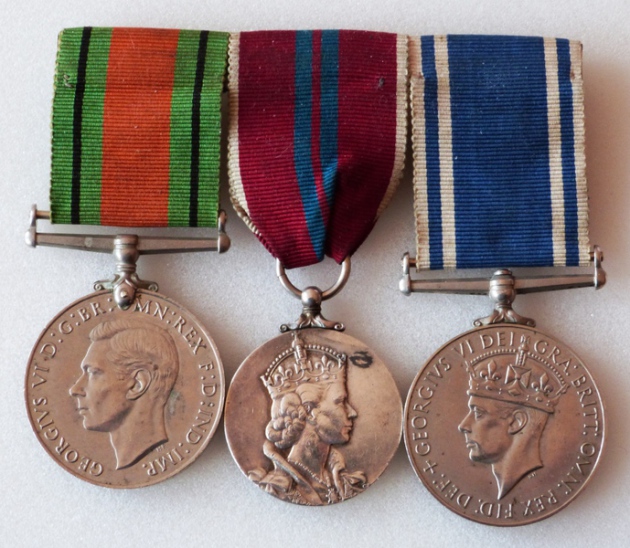 PC Eder Perrie Smith's Defence Medal, Coronation Medal, 1953 and Police Long Service & Good Conduct Medals
PC Eder Perrie Smith's Defence Medal, Coronation Medal, 1953 and Police Long Service & Good Conduct Medals
The Defence Medal
The Queen Elizabeth II Coronation Medal
The Police Long Service & Good Conduct Medal (GVIR)
Edinburgh City Police
PC Eder Perrie Smith
Eder Perrie Smith joined Edinburgh City Police on 19 April 1927.
He retired on pension on 2 September 1957.
He died in the City Hospital, Edinburgh on 29 January, 1980. His home address was 7 Parkside Terrace, Edinburgh. His name was listed in The Edinburgh Gazette of Friday 21 August 1981 under "Estates Fallen to the Crown".
PS 64 B Alexander Strachan Edinburgh City Police
King Edward VII Police (Scotland) Medal 1903
King George V Coronation (Scottish Police) Medal 1911
Edinburgh City Police
PC Alexander Strachan
Alexander Strachan, the son of PC Charles Strachan of City of Glasgow Police was born on 5 November, 1869 at 21Balmanno Street, Glasgow.
His father resigned from the force in 1871 and the family moved to Inverurie in Aberdeenshire.
It was from there on 11August, 1886 that he enlisted in the Scots Guards as Guardsman 7256.
Alexander Strachan served 3 years in the 2nd Battalion Scots Guards, serving in Caterham and London and twice in the Curragh and Dublin in Ireland before joining Ayrshire Constabulary on 1 July 1890.
According to his Army Record, he was not entitled to any medals or decorations for his service.
PC Strachan served in Ayrshire Constabulary to 23 April 1894 when he resigned to join Edinburgh City Police. His conduct was described as "Very Good" by Ayrshire Constabulary.
On 26 January, 1900, he was commended (Awarded) for:
|
“Awarded 10/- for courageous conduct in stopping a runaway horse.”
|
Unfortunately, his record also shows the following under “Punishments, Reductions etc.”
|
“9 July, 1901. Fined 2/6 N.L.P.(No loss of Pay) for failing to report immediately to his Superintendent a statement made by another constable as to that Constable having committed a theft.”
|
|
“22 March, 1906. Reduced to 2nd Class 1st Grade for that he did on a date about three or four years ago repeat unofficially by way of gossip to a superior officer a scandalous and untruthful statement severely reflecting on the moral character of the Chief Constable.”
|
The incident for which he was punished in 1906 is intriguing and I will follow it up eventually.
He seems to have “Tholed his Assize” because there are no other punishments recorded and on 18 August 1914, he was promoted to 4th Class Sergeant on 39/1d a week as PS 64 B at Gayfield. By the time he retired, he was on 110/- per week.
He retired on pension from Edinburgh City Police as a Sergeant on 13 March 1922.
PS Strachan can be seen wearing his medals in the picture immediately below.
PC William Sutherland Edinburgh City Police
Lieutenant Ernest John Thurgar Edinburgh City Police
King Edward VII Police (Scotland) Medal 1903
Edinburgh City Police
Lieutenant Ernest John Thurgar
Ernest John Thurgar was born in Dover in Kent on 21 January 1876. His father was William Thurgar and his mother, Mary Jane Thurgar.
In the Census of 1881, he was aged 5 and his family was living in Canterbury in Kent.
By the time he was 15 in 1891, the Census has his father and mother as ‘Master and Matron of the Canterbury Union Workhouse.
On 19 February 1898 at Barton Regis in Bristol, Gloucestershire, Ernest John Thurgar married Edith Annie Veysey.
Page 536 of Conduct book 4 of Edinburgh City Police confirms that Ernest Thurgar was appointed as a Lieutenant in the force on Wednesday 21 August 1907.
The Weekly Record dated that date confirms under “Appointments” that:
|
“Ernest Thurgar, Assistant Chief Clerk Bradford, Lieutenant and Chief Clerk vice Lieutenant James Louden transferred to the Charge Office.” |
According to the 1901 Census, living at 354 Morningside Road, Edinburgh was Ernest J. Thurgar (25) and Edith A. Thurgar (28). His occupation was ‘Lieutenant, City Constabulary’.
On 30 March 1902, Winifred Francis Mary Thurgar was born at 354 Morningside Road, Edinburgh. Her father registered her birth and gave his occupation as ‘Lieutenant, Edinburgh City Constabulary’.
By March, 1905, Ernest Thurgar was a “1st Grade, 1st Class Lieutenant” according to the entries in the Weekly Record.
The Weekly Record of Tuesday 5 March 1907 records that:
|
“Lieutenant William D. Paterson to be Chief Clerk vice Lieutenant Ernest Thurgar resigned.” |
His story now takes a strange turn.
There is a document dated 12 March 1911 showing him crossing the border between Montreal, Canada and Detroit, Michigan, USA to meet “…a friend, E.J. Hazzard, King Hospital, Detroit”. He had arrived in Montreal on the SS “Tunisian”.
In the Census of 1911 in England, Edith Annie Thurgar and her daughter Winifred are recorded living in a ‘Home for Crippled Boys’ in Kensington, London where Edith is the ‘Matron’.
On 10 August 1911, Ernest John Thurgar married Ellen Jane Hazzard in Detroit.
On 14 August 1914, Ernest John Thurgar enlisted in the Canadian Overseas expeditionary Force. He was a Captain in the Canadian Army Medical Corps CAMC). His occupation is given as “Retired Accountant”.
He was posted to the United Kingdom in October 1914 as Quartermaster (QM) of a CAMC General Hospital. He was posted to France in November 1915. In 1916, he was posted to Buxton in Derbyshire. He also served as QM in General Hospitals in Bromley, Kent and Eastbourne, East Sussex.
His next of kin on his CAMC papers is “Ellen Jane Thurgar, (Wife), 34 Tippcott Hill, Shepton Mallett in Somerset, England.” His papers also show a “Separation Allowance” paid via The Bank of Montreal London branch to Ellen Jane Thurgar.
Ernest John Thurgar sailed from England to Canada on the SS Metagama on 27 June 1919 and was demobbed on 6 October 1919.
A Canadian Medal Index Card (MIC) shows
Captain Thurgar’s entitlement to a 1914-15 Star on Medal Roll B. Page 20540 and the medals were receipted from “1 Bungalow, Holton Heath, Wareham, (Dorset) England” 0n 27 May 1925.
On 8 November 1919 on the SS “Saturnia owned by the Anchor-Donaldson Line, from Montreal to Glasgow, Ernest John Thurgar and Ellen Jane Thurgar returned to the United Kingdom.
Ernest John Thurgar died in Hamworthy, Dorset in June 1931. He was buried there on 16 June 1931.
As yet, I have found no trace of a Divorce between Ernest and Edith in the UK or in Canada.
The medal is in poor condition as if it has been buried in soil for some time. Just another part of the mystery to be solved?
PS William Thomas Uffendell Edinburgh City Police
King Edward VII Police (Scotland) Medal 1903
King George V Coronation (Scottish Police) Medal 1911
Edinburgh City Police
PS William Thomas Uffendell
PS Uffendell served in the Royal Scots Greys in England, at Piershill Barracks in Edinburgh and in Ireland before joining Edinburgh City Police.
PC 312 B Charles Wickham KPM Edinburgh City Police
The King’s Police Medal for Gallantry (1934)
Edinburgh City Police
PC Charles Wickham KPM
Charles Spence Wickham was born on 27 February, 1911 in Gorebridge Midlothian.
He joined Edinburgh City Police as PC 76 A just short of his 20th birthday on 10 February, 1931. He later transferred to Gayfield as PC 312 B.
On 16 May, 1933, PC Charles Wickham was “Highly Commended for promptitude and courage displayed in stopping a runaway horse.”
The London Gazette of 1 January, 1934 records the following:
Whitehall, January 1, 1934
His Majesty the KING has been graciously pleased to award the King’s Police Medal to the Officers of Police and Fire Brigades whose names appear below:-
Police: Scotland
Charles Wickham, Constable, Edinburgh City Police Force.”
The Police Review and Parade Gossip of 2 February 1934 records the following on page 79:
“PC Charles Wickham (Edinburgh) was awarded the medal for his gallantry on 3rd May of last year (1933) in stopping a runaway horse attached to a coal lorry.
The Constable jumped off a tramcar when he saw the runaway, rushed at its head, and holding by the bridle, was dragged a distance of about 30 yards; then to prevent collision with a plate-glass window and injury to children, he threw himself in front of the horse and guided it towards a van, with which it collided.
The Constable afterwards tripped up the horse and held it down, at the same time soothing the frantic animal, until he obtained assistance.
Constable Wickham was awarded an honorary certificate and £10 by the Carnegie Hero Fund Trustees in July, in recognition of his gallant action.
He is a great lover of horses and spends his spare time breaking-in two year-old thoroughbreds. He is considered a good amateur rider.”
On 1 October, 1935 Charles Wickham was again “Highly Commended for alertness and resourcefulness displayed in effecting the arrest of a motor car thief.”
On 20 September, 1936, he was transferred to D Division (Leith Docks) as PC 624 D.
On 1 February, 1938, PC Charles Wickham was transferred to E Division (Mounted Contingent) as PC 719 E.
Charles Wickham “Resigned for Service in H.M Services.” on 14 December, 1939.
The Weekly Record lists two further entries for advancements of pay in 1940 and 1941 but the final entry in PC Wickham’s Personnel Records is as follows.
27 August, 1945 “Resigned from Police Force.”
I have been unable so far, to establish which of the services Charles Spence Wickham served in during the Second World War.
Two possibilities are shown below.
The London Gazette of 16 June, 1944 has an entry as follows:
The undermentioned to be 2nd Lts.:-
28 February, 1942:-
327930 Serjt. Charles Spence Wickham (318760) from R.A.C (Royal Armoured Corps)
The London Gazette of 1 January, 1945 lists a Mention in Despatches to
“1101807 C.S. Wickham, Royal Air Force Volunteer Reserve.”
If you know the correct unit, please get in touch with the website.
I believe that Charles Spence Wickham died in Leith in 1987 aged 75 years.
The images of the medal here are not the original KPM for Gallantry. If you are able to help with an original image of PC Wickham’s medal, please get in touch with the website.
PC 360 C Alexander Innes Will Edinburgh City Police
King George V Coronation (Scottish Police) Medal 1911
Edinburgh City Police
PC 360 C Alexander Innes Will
He joined Edinburgh City Police on 10 September, 1907 and transferred to Sutherland-shire Constabulary on 12 August, 1913.
The photograph below shows him years later as a Sergeant in Sutherland-shire Constabulary.
Please click here to see the entry under Sutherland-shire Constabulary.
PC 560 D Robert Work Edinburgh City Police
King Edward VII Police (Scotland) Medal 1903
King George V Coronation (Scottish Police) Medal 1911
Edinburgh City Police
PC 560 D Robert Work
Robert Work was born on 4 April, 1877 in Shapinsay in Orkney.
He joined Edinburgh City Police on 8 January, 1901 on a weekly pay of £0. 23/6d (just slightly over£1.17) and was posted to the West End as PC 560 D.
He was Commended by the Chief Constable and awarded "10 shillings" (£0.50) each time in 1906 and 1917 for "stopping a Runaway Horse".
He retired on pension on 12 January, 1931.
